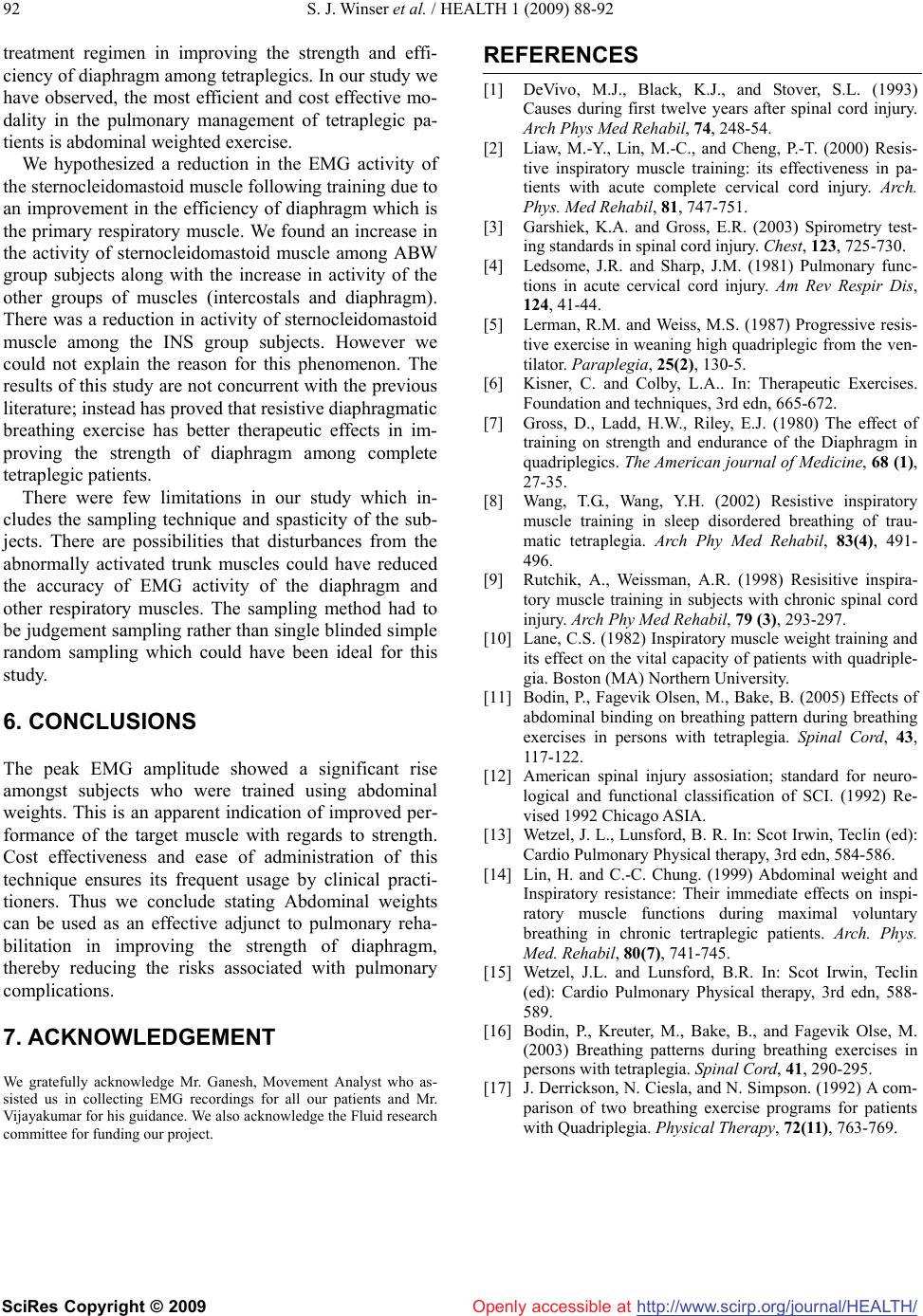
S. J. Winser et al. / HEALTH 1 (2009) 88-92
http://www.scirp.org/journal/HEALTH/
92
Openly accessible at
treatment regimen in improving the strength and effi-
ciency of diaphragm among tetraplegics. In our study we
have observed, the most efficient and cost effective mo-
dality in the pulmonary management of tetraplegic pa-
tients is abdominal weighted exercise.
We hypothesized a reduction in the EMG activity of
the sternocleidomastoid muscle following training due to
an improvement in the efficiency of diaphragm which is
the primary respiratory muscle. We found an increase in
the activity of sternocleidomastoid muscle among ABW
group subjects along with the increase in activity of the
other groups of muscles (intercostals and diaphragm).
There was a reduction in activity of sternocleidomastoid
muscle among the INS group subjects. However we
could not explain the reason for this phenomenon. The
results of this study are not concurrent with the previous
literature; instead has proved that resistive diaphragmatic
breathing exercise has better therapeutic effects in im-
proving the strength of diaphragm among complete
tetraplegic patients.
There were few limitations in our study which in-
cludes the sampling technique and spasticity of the sub-
jects. There are possibilities that disturbances from the
abnormally activated trunk muscles could have reduced
the accuracy of EMG activity of the diaphragm and
other respiratory muscles. The sampling method had to
be judgement sampling rather than single blinded simple
random sampling which could have been ideal for this
study.
6. CONCLUSIONS
The peak EMG amplitude showed a significant rise
amongst subjects who were trained using abdominal
weights. This is an apparent indication of improved per-
formance of the target muscle with regards to strength.
Cost effectiveness and ease of administration of this
technique ensures its frequent usage by clinical practi-
tioners. Thus we conclude stating Abdominal weights
can be used as an effective adjunct to pulmonary reha-
bilitation in improving the strength of diaphragm,
thereby reducing the risks associated with pulmonary
complications.
7. ACKNOWLEDGEMENT
We gratefully acknowledge Mr. Ganesh, Movement Analyst who as-
sisted us in collecting EMG recordings for all our patients and Mr.
Vijayakumar for his guidance. We also acknowledge the Fluid research
committee for funding our project.
REFERENCES
[1] DeVivo, M.J., Black, K.J., and Stover, S.L. (1993)
Causes during first twelve years after spinal cord injury.
Arch Phys Med Rehabil, 74, 248-54.
[2] Liaw, M.-Y., Lin, M.-C., and Cheng, P.-T. (2000) Resis-
tive inspiratory muscle training: its effectiveness in pa-
tients with acute complete cervical cord injury. Arch.
Phys. Med Rehabil, 81, 747-751.
[3] Garshiek, K.A. and Gross, E.R. (2003) Spirometry test-
ing standards in spinal cord injury. Chest, 123, 725-730.
[4] Ledsome, J.R. and Sharp, J.M. (1981) Pulmonary func-
tions in acute cervical cord injury. Am Rev Respir Dis,
124, 41-44.
[5] Lerman, R.M. and Weiss, M.S. (1987) Progressive resis-
tive exercise in weaning high quadriplegic from the ven-
tilator. Paraplegia, 25(2), 130-5.
[6] Kisner, C. and Colby, L.A.. In: Therapeutic Exercises.
Foundation and techniques, 3rd edn, 665-672.
[7] Gross, D., Ladd, H.W., Riley, E.J. (1980) The effect of
training on strength and endurance of the Diaphragm in
quadriplegics. The American journal of Medicine, 68 (1),
27-35.
[8] Wang, T.G., Wang, Y.H. (2002) Resistive inspiratory
muscle training in sleep disordered breathing of trau-
matic tetraplegia. Arch Phy Med Rehabil, 83(4), 491-
496.
[9] Rutchik, A., Weissman, A.R. (1998) Resisitive inspira-
tory muscle training in subjects with chronic spinal cord
injury. Arch Phy Med Rehabil, 79 (3), 293-297.
[10] Lane, C.S. (1982) Inspiratory muscle weight training and
its effect on the vital capacity of patients with quadriple-
gia. Boston (MA) Northern University.
[11] Bodin, P., Fagevik Olsen, M., Bake, B. (2005) Effects of
abdominal binding on breathing pattern during breathing
exercises in persons with tetraplegia. Spinal Cord, 43,
117-122.
[12] American spinal injury assosiation; standard for neuro-
logical and functional classification of SCI. (1992) Re-
vised 1992 Chicago ASIA.
[13] Wetzel, J. L., Lunsford, B. R. In: Scot Irwin, Teclin (ed):
Cardio Pulmonary Physical therapy, 3rd edn, 584-586.
[14] Lin, H. and C.-C. Chung. (1999) Abdominal weight and
Inspiratory resistance: Their immediate effects on inspi-
ratory muscle functions during maximal voluntary
breathing in chronic tertraplegic patients. Arch. Phys.
Med. Rehabil, 80(7), 741-745.
[15] Wetzel, J.L. and Lunsford, B.R. In: Scot Irwin, Teclin
(ed): Cardio Pulmonary Physical therapy, 3rd edn, 588-
589.
[16] Bodin, P., Kreuter, M., Bake, B., and Fagevik Olse, M.
(2003) Breathing patterns during breathing exercises in
persons with tetraplegia. Spinal Cord, 41, 290-295.
[17] J. Derrickson, N. Ciesla, and N. Simpson. (1992) A com-
parison of two breathing exercise programs for patients
with Quadriplegia. Physical Therapy, 72(11), 763-769.
SciRes Copyright © 2009